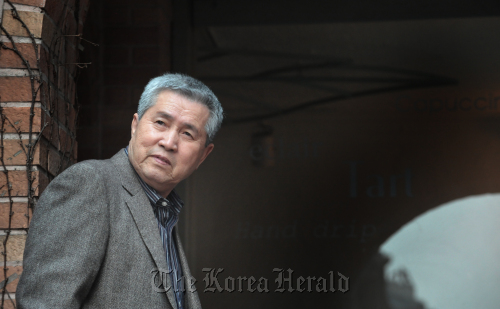Im Kwon-taek’s ‘Hanji’ features ‘moon-like’ beauty of traditional Korean mulberry paper
After making a series of films that were “replicas of Hollywood films” in the 1960s, director Im Kwon-taek set one solid goal in his mind.
“The films I made in the 1960s were solely created for box-office profits and audience appeal,” Im told The Korea Herald on Monday. “But I wanted to get away from that American style and make Korean films that can be only made through a Korean person.”
So he did. His works in the past three decades ― notably, “The Surrogate Woman” (1986), “Seopyeonje” (1993), “Chunhyang” (2000), “Painted Fire” (2002) and “Beyond the Years” (2007) ― share an original and poignant display of traditional Korean sentiment and culture.
His 101th film, which will be released on Thursday, is no exception in that sense. It keeps to Korean culture and tradition, featuring a group of people who try to regain the status of and preserve “hanji,” Korea’s traditional mulberry paper.
Yet the director says the upcoming movie breaks from his past 100.
“I felt I really had to do something new, do something different this time,” Im told The Korea Herald. “So I applied many documentary-style elements in this movie.”
After making a series of films that were “replicas of Hollywood films” in the 1960s, director Im Kwon-taek set one solid goal in his mind.
“The films I made in the 1960s were solely created for box-office profits and audience appeal,” Im told The Korea Herald on Monday. “But I wanted to get away from that American style and make Korean films that can be only made through a Korean person.”
So he did. His works in the past three decades ― notably, “The Surrogate Woman” (1986), “Seopyeonje” (1993), “Chunhyang” (2000), “Painted Fire” (2002) and “Beyond the Years” (2007) ― share an original and poignant display of traditional Korean sentiment and culture.
His 101th film, which will be released on Thursday, is no exception in that sense. It keeps to Korean culture and tradition, featuring a group of people who try to regain the status of and preserve “hanji,” Korea’s traditional mulberry paper.
Yet the director says the upcoming movie breaks from his past 100.
“I felt I really had to do something new, do something different this time,” Im told The Korea Herald. “So I applied many documentary-style elements in this movie.”

The movie, “Hanji,” tells the story of Pil-yong (Park Joong-hoon), a low-level civil servant in Jeonju, North Jeolla Province, who works for a government-funded hanji restoration project in the region. The project is to restore a copy of the annals of the Joseon Dynasty using hanji of a traditional kind.
Desperate for promotion, Pil-yong, almost desperately, contacts hanji makers in Jeonju and persuades them to participate in the project.
The project in the movie is based on a real-life project funded by the city of Jeonju, which suffered from lack of funding and discord between hanji makers in the city.
“I hired many real-life people who had participated in the project to appear in the film,” Im told The Korea Herald. “I did not ask them to act. I asked them to show me exactly what they’d said in the past. It worked out really well.”
In the film, Pil-yong soon gets assigned to assist documentary filmmaker Ji-won (Kang Soo-yeon) who is working on a film about hanji. Through Ji-won’s own informational interview clips and footage of hanji, the movie blurs the boundary between fiction and non-fiction throughout.
“This movie was funded one third by city of Jeonju,” Im said. “And I am aware that this movie can be seen as almost a promotional film of hanji and the city. Yet if this movie is only seen as such a promotional film, then I wouldn’t say I’m a good director.”
Im said the movie is about people who are “crazy” about hanji and its beauty, in spite of the harsh reality the paper is facing.
“It is almost impossible to create the kind of hanji that was produced in the good old days,” Im said. “It is because our soil, water and air are polluted and such things affect the quality of hanji. And even if hanji lasts 1,000 years, it does not have a lot of meaning to the modern world. We have DVDs and photocopiers. And we wouldn’t buy a piece of paper for 100,000 won.”
In the film, Pil-yong and Ji-won try to re-create the original hanji under the moonlight with groups of other people.
Pil-yong’s wife (Ye Ji-won), who suffers from the effects of a stroke, tells Ji-won that hanji is very much like the moonlight.
“The moonlight is never too bright to make you frown,” she says.
“It’s calm, subtle, soft yet enduring. Just like a piece of hanji.”
By Claire Lee (clairelee@heraldcorp.com)








![[KH Explains] How should Korea adjust its trade defenses against Chinese EVs?](http://res.heraldm.com/phpwas/restmb_idxmake.php?idx=644&simg=/content/image/2024/04/15/20240415050562_0.jpg&u=20240415144419)










![[Today’s K-pop] Stray Kids to return soon: report](http://res.heraldm.com/phpwas/restmb_idxmake.php?idx=642&simg=/content/image/2024/04/16/20240416050713_0.jpg&u=)